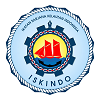Keanekaragaman Fitoplankton dan Kaitannya Dengan Kondisi Perairan di Senggarang Besar, Kota Tanjungpinang, Kepulauan Riau
Abstract
ABSTRACT
The existence of phytoplankton in water can provide information about the state of the waters. Changes in water quality can be seen from the abundance and composition of phytoplankton. The purpose of this study was to determine the diversity of phytoplankton, to determine the relationship between the abundance of phytoplankton and environmental conditions, to determine the quality of the waters based on the diversity of phytoplankton in Senggarang Besar. The research method used is a survey method. This study took 10 sampling points with the Systematic Random Sampling method. Data analysis used is an ecological index, multiple regression lines, correlation, and ANOVA. The diversity index value in the waters of Senggarang Besar Tanjungpinang City is in the low category, with the results of identifying phytoplankton from the whole weekly found 3 divisions with 21 genera, the three divisions include Bacillariophyta (18 genera), Dinophyta (2 genera), and Chlorophyta (1 genus). The parameter that has the highest correlation with the abundance of phytoplankton is the parameter of nitrate (NO3), while the comparison of the abundance of phytoplankton per week in Senggarang Besar waters shows that the combination between the first week and the second week is very significantly different, the combination of the first week with the third week is very significantly different and the combination is significantly different in the second and third week. Based on the saprobic index in Senggarang Besar waters, it is categorized into the class of oligosaprobic/very light organic matter pollution.
Keywords: Diversity, Phytoplankton, Saprobic, Senggarang Besar Waters.
ABSTRAK
Keberadaan fitoplankton di suatu perairan dapat memberikan informasi mengenai keadaan perairan. Perubahan terhadap kualitas perairan dapat ditinjau dari kelimpahan dan komposisi fitoplankton. Penelitian ini dilakukan untuk mengetahui keanekaragaman fitoplankton, mengetahui kaitan antara kelimpahan fitoplankton dengan kondisi lingkungan dan kualitas perairan berdasarkan keanekaragaman fitoplankton di Senggarang Besar. Metode penelitian yang digunakan adalah metode survei. Penelitian ini mengambil 10 titik sampling dengan metode Sistematik Random Sampling. Analisis data yang digunakan yaitu indeks ekologi, regresi linier berganda, korelasi, dan ANOVA. Nilai indeks keanekaragaman di perairan Senggarang Besar Kota Tanjungpinang dalam kategori rendah, dengan hasil identifikasi fitoplankton dari keseluruhan perminggu ditemukan 3 divisi dengan 21 genera, ketiga divisi tersebut antara lain Bacillariophyta (18 genera), Dinophyta (2 genera), dan Chlorophyta (1 genus). Parameter yang berkorelasi paling tinggi terhadap kelimpahan fitoplankton adalah parameter nitrat (NO3). Perbandingan kelimpahan fitoplankton perminggu di Perairan Senggarang Besar menunjukkan bahwa kombinasi antara minggu pertama dan minggu kedua berbeda sangat nyata, kombinasi minggu pertama dengan minggu ketiga berbeda sangat nyata dan kombinasi pada minggu kedua dan minggu ketiga berbeda nyata. Berdasarkan indeks saprobik di perairan Senggarang Besar terkategori ke dalam golongan pencemaran bahan organik Oligosaprobik/sangat ringan.
Kata kunci: Fitoplankton, Keanekaragaman, Perairan Senggarang Besar, Saprobik
Full Text:
PDF (Bahasa Indonesia)References
American Public Health Association (APHA). (2017). Standard Methods for the Examination of Water and Wastewater. 23RD Edition. American Public Health Association, Washington DC.
Armiani, S., & Harisanti, B. M. (2021). Hubungan Kemelimpahan Fitoplankton dengan Faktor Lingkungan di Perairan Pantai Desa Madayin Lombok Timur. Jurnal Pijar Mipa, 16(1), 75-80.
Aryani, M., Fitriani, L., Harmoko, H., & Sepriyaningsih, S. (2020). Mikroalga Divisi Bacillariophyta Yang Ditemukan Di Sungai Kasie Kecamatan Lubuklinggau Barat I Kota Lubuklinggau. Florea: Jurnal Biologi Dan Pembelajarannya, 7(1), 48-53.
Chiang, C., Olsen, J. E., Basler, D., Bånkestad, D., & Hoch, G. (2019). Latitude and weather influences on sun light quality and the relationship to tree growth. Forests, 10(8), 610.
Davis, C. C. (1955). The Marine and Fresh Water Plankton. Michigan State University Press.
Dresscher, T. G., & Van der Mark, H. (1976). A simplified method for the biological assessment of the quality of fresh and slightly brackish water. Hydrobiologia, 48(3), 199-201.
Handoko, H., Yusuf, M., & Wulandari, S. Y. (2013). Sebaran nitrat dan fosfat dalam kaitannya dengan kelimpahan fitoplankton di Kepulauan Karimunjawa. Journal of Oceanography, 2(3), 198-206.
Hasani, Q., Adiwilaga, E. M., & Pratiwi, N. T. M. (2012). The relationship between the harmful algal blooms (habs) phenomenon with nutrients at shrimp farms and fish cage culture sites in pesawaran district Lampung Bay. Makara Journal of Science, 16(3), 183-191.
Indrayana, R., Yusuf, M., & Rifai, A. (2014). Pengaruh arus permukaan terhadap sebaran kualitas air di perairan Genuk Semarang. Journal of Oceanography, 3(4), 651-659.
Juadi, J., Dewiyanti, I., & Nurfadillah, N. (2018). Komposisi Jenis dan Kelimpahan Fitoplankton di Perairan Ujong Pie Kecamatan Muara Tiga Kabupaten Pidie. Jurnal Ilmiah Mahasiswa Kelautan Perikanan Unsyiah, 3(1).
Napitupulu, R., Muskananfola, M. R., & Sulardiono, B. (2021). Hubungan kandungan nitrat dan fosfat dengan kelimpahan fitoplankton di perairan Desa Timbulsloko, Kabupaten Demak. Jurnal Pasir Laut, 5(1), 63-68.
Nontji, A. (2008). Plankton Laut. LIPI Press. Jakarta: LIPI.
Odum, E.P. (1993). Dasar-dasar Ekologi. Edisi Ketiga. Diterjemahkan Oleh T. Samingan, dan B. Srigandono. Gajah Mada University Press.Yogyakarta. xv + 697 hal.
Purnobasuki, H., & Hermawan, A. (2022). Litter fall and decomposition of mangrove species Avicennia marina in Surabaya East Coast, Indonesia. Pakistan Journal of Botany, 54(4), 1399-1403.
Putra, A. W., & Hasan, Z. (2012). Struktur Komunitas Plankton di Sungai Citarum Hulu Jawa Barat. Jurnal Perikanan Kelautan, 3(4).
Sulasteri, S., Apriadi, T., & Melani, W. R. (2022). Tingkat Kesuburan Perairan Desa Mantang Baru, Kecamatan Mantang, Kabupaten Bintan. Jurnal Kelautan: Indonesian Journal of Marine Science and Technology, 15(2), 100-105.
Tan, K. S., & Ransangan, J. (2017). Effects of nutrients and zooplankton on the phytoplankton community structure in Marudu Bay. Estuarine, Coastal and Shelf Science, 194, 16-29.
Tomascik, T., A.J. Mah, A. Nontji and M.K. Moosa. (1997). The Ecology of the Indonesian Seas. Part Two. The Ecology of Indonesian Series. Vol. VIII. Periplus Editions Ltd. Singapore. 567 pp.
Yamaji, I.(1979). Ilustrations of the Marine Plankton of Japan. Osaka Jepang: Hoikusha Publishing Co.
DOI: https://doi.org/10.21107/jk.v17i1.18184
Refbacks
- There are currently no refbacks.

This work is licensed under a Creative Commons Attribution 4.0 International License.

Jurnal Kelautan by Program Studi Ilmu Kelautan is licensed under a Creative Commons Attribution 4.0 International License.
Published by: Department of Marine Sciences, Trunojoyo University of Madura













